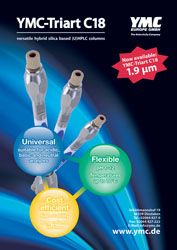YMC HPLC Columns:
YMC Product Profile

Chromatographers always seek to push the limits of HPLC columns to greater extremes to allow them to perform day-to-day with ever-changing pH, buffers and temperature ranges. The column for the laboratory of today must be suitable for harsh pH conditions in combination with high temperature ranges without sacrificing selectivity. Additionally narrow, symmetric peak shapes are necessary in order to cope with rapid analysis of demanding samples.
In order to meet these goals, YMC have developed a new particle technology. This is based on a multilayered particle produced via a well controlled granulation technology. The revolutionary production technique provides a multilayer silica-organic hybrid stationary phase, with an outstandingly narrow pore size and particle size distribution which, in turn, results in low back pressures and high loadability.
In addition, a proprietary multi-stage endcapping technique provides outstanding peak shapes, even for basic compounds. The innovative endcapping process also allows very high LC-MS sensitivity to be obtained which makes YMC-Triart an excellent first choice for residue analysis or any routine method development.
YMC-Triart columns are available with 1.9, 3 and 5 micron particles in various column sizes for (U)HPLC, inclusive Actus for fast semi-preparative HPLC.

New Method Explored for the Detection of CECs in Crops Irrigated with Contaminated Water
April 30th 2025This new study presents a validated QuEChERS–LC-MS/MS method for detecting eight persistent, mobile, and toxic substances in escarole, tomatoes, and tomato leaves irrigated with contaminated water.
Accelerating Monoclonal Antibody Quality Control: The Role of LC–MS in Upstream Bioprocessing
This study highlights the promising potential of LC–MS as a powerful tool for mAb quality control within the context of upstream processing.
University of Tasmania Researchers Explore Haloacetic Acid Determiniation in Water with capLC–MS
April 29th 2025Haloacetic acid detection has become important when analyzing drinking and swimming pool water. University of Tasmania researchers have begun applying capillary liquid chromatography as a means of detecting these substances.

.png&w=3840&q=75)

.png&w=3840&q=75)



.png&w=3840&q=75)



.png&w=3840&q=75)




